Haptic Interface with Twin-Driven MR Fluid Actuator for Teleoperation Endoscopic Surgery System
Abstract
:1. Introduction
2. Haptic Interface for Tele-Operational Endoscopic Surgery and Leader-Follower Systems
2.1. Basic Structure of the Haptic Interface
2.2. Kinematics and Statics of the Haptic Interface
2.3. Basic Structure of the Follower System
2.4. Controller for the Leader-Follower System
3. Methods
4. Results
4.1. Success Rate
4.2. Subjective Analysis
5. Discussion
6. Conclusions
Author Contributions
Funding
Conflicts of Interest
References
- Siciliano, B.; Khatib, O. Handbook of Robotics, 2nd ed.; Section 43; Telerobotics; Springer: Berlin/Heidelberg, Germany, 2016; pp. 1085–1108. [Google Scholar]
- Corke, P. Robotics, Vision and Control, 2nd ed.; Springer: Berlin, Germany, 2017; pp. 6–7. [Google Scholar]
- Simorov, A.; Stephen Otte, R.; Kopietz, C.; Oleynikov, D. Review of surgical robotics user interface: What is the best way to control robotic surgery. Surg. Endosc. 2012, 26, 2117–2125. [Google Scholar] [CrossRef] [PubMed]
- Hannaford, B. A design framework for teleoperators with kinesthetic feedback. IEEE Trans. Robot. Autom. 1989, 5, 426–434. [Google Scholar] [CrossRef] [Green Version]
- Yokokohji, Y.; Yoshikawa, T. Bilateral control of master–slave manipulators for ideal kinesthetic coupling-formulation and experiment. IEEE Trans. Robot. Autom. 1994, 10, 605–620. [Google Scholar] [CrossRef] [PubMed] [Green Version]
- Tavakoli, M.; Aziminejad, A.; Patel, R.; Moallem, M. High-fidelity bilateral teleoperation systems and the effect of multimodal haptics. IEEE Trans. Syst. Man Cybern.—Part. B Cybern. 2007, 37, 1512–1528. [Google Scholar] [CrossRef] [PubMed]
- Hiki, N.; Honda, M.; Etoh, T.; Yoshida, K.; Kodera, Y.; Kakeji, Y.; Kumamaru, H.; Miyata, H.; Yamashita, Y.; Inomata, M.; et al. Higher indicate of pancreatic fistula in laparoscopic gastrectomy. Real-world evidence from a nationwide prospective cohort study. Gastr. Cancer 2018, 21, 162–170. [Google Scholar] [CrossRef] [PubMed]
- Uyama, I.; Suda, K.; Nakauchi, M.; Kinoshita, T.; Noshiro, H.; Takiguchi, S.; Ehara, K.; Obama, K.; Kuwabara, S.; Okabe, H.; et al. Clinical advantages of robotics gastrectomy for clinical stage I/II gastric cancer: A multi-institutional prospective single-arm study. Gastr. Cancer 2019, 22, 377–385. [Google Scholar] [CrossRef] [PubMed] [Green Version]
- Japan Society for Endoscopic Surgery. 15th Nationwide Survey of Endoscopic Surgery in Japan; Japan Society for Endoscopic Surgery: Tokyo, Japan, 2020; p. 98. [Google Scholar]
- Roberts, W.B.; Tseng, K.; Walsh, P.C.; Han, M. Critical appraisal of management of rectal injury during radical prostatectomy. Urology 2017, 76, 1088–1091. [Google Scholar] [CrossRef] [PubMed]
- Soomro, N.A.; Hashimoto, D.A.; Porteous, A.J.; Ridley CJ, A.; Marsh, W.J.; Ditto, R.; Roy, S. Systematic review of learning curves in robot-assisted surgery. BJS Open 2019, 4, 27–44. [Google Scholar] [CrossRef] [PubMed] [Green Version]
- Stephan, D.; Salzer, H.; Willeke, F. First Experiences with the New Senhance Telerobotic System in Visceral Surgery. Visc. Med. 2018, 34, 31–36. [Google Scholar] [CrossRef] [PubMed]
- Kikuchi, T.; Abe, I.; Nagata, T.; Yamaguchi, A.; Takano, T. Twin-Driven Actuator with Multi-layered Disc MR Fluid Clutches for Haptics. J. Intell. Mater. Syst. Struct. 2020. [Google Scholar] [CrossRef]
- Kikuchi, T.; Otsuki, K.; Furusho, J.; Abe, H.; Noma, J.; Naito, M.; Lauzier, N. Development of compact MR fluid clutch for human-friendly actuator. Adv. Robot. 2010, 24, 1489–1502. [Google Scholar] [CrossRef]
- Carlson, J.; Jolly, M. MR fluid, foam and elastomer devices. Mechatronics 2000, 10, 555–569. [Google Scholar] [CrossRef]
- Kikuchi, T.; Noma, J.; Akaiwa, S.; Ueshima, Y. Response time of magnetorheological fluid-based haptic device. J. Intell. Mater. Syst. Struct. 2015, 27, 859–865. [Google Scholar] [CrossRef]
- Fauteux, P.; Lauria, M.; Heintz, B.; Michaud, F. Dual-differential rheological actuator for high-performance physical robotics interaction. IEEE Trans. Robot. 2010, 26, 607–618. [Google Scholar] [CrossRef]
- Choi, S.H.; Kim, S.; Kim, P.; Park, J.; Choi, S.B. A new visual feedback-based magnetorheological haptic master for robot-assisted minimally invasive surgery. Smart Mater. Struct. 2015, 24, 065015. [Google Scholar] [CrossRef]
- NASA TLX. Available online: https://humansystems.arc.nasa.gov/groups/TLX/ (accessed on 7 July 2021).
- Brragan, J.A.; Chanci, D.; Yu, D.; Wachs, J.P. SACHETS: Semi-autonomous Cognitive Hybrid Emergency Teleoperated Suction. In Proceedings of the 30th IEEE International Conference on Robot & Human Interactive Communication, Online, 8–12 August 2021; pp. 1243–1248. [Google Scholar]
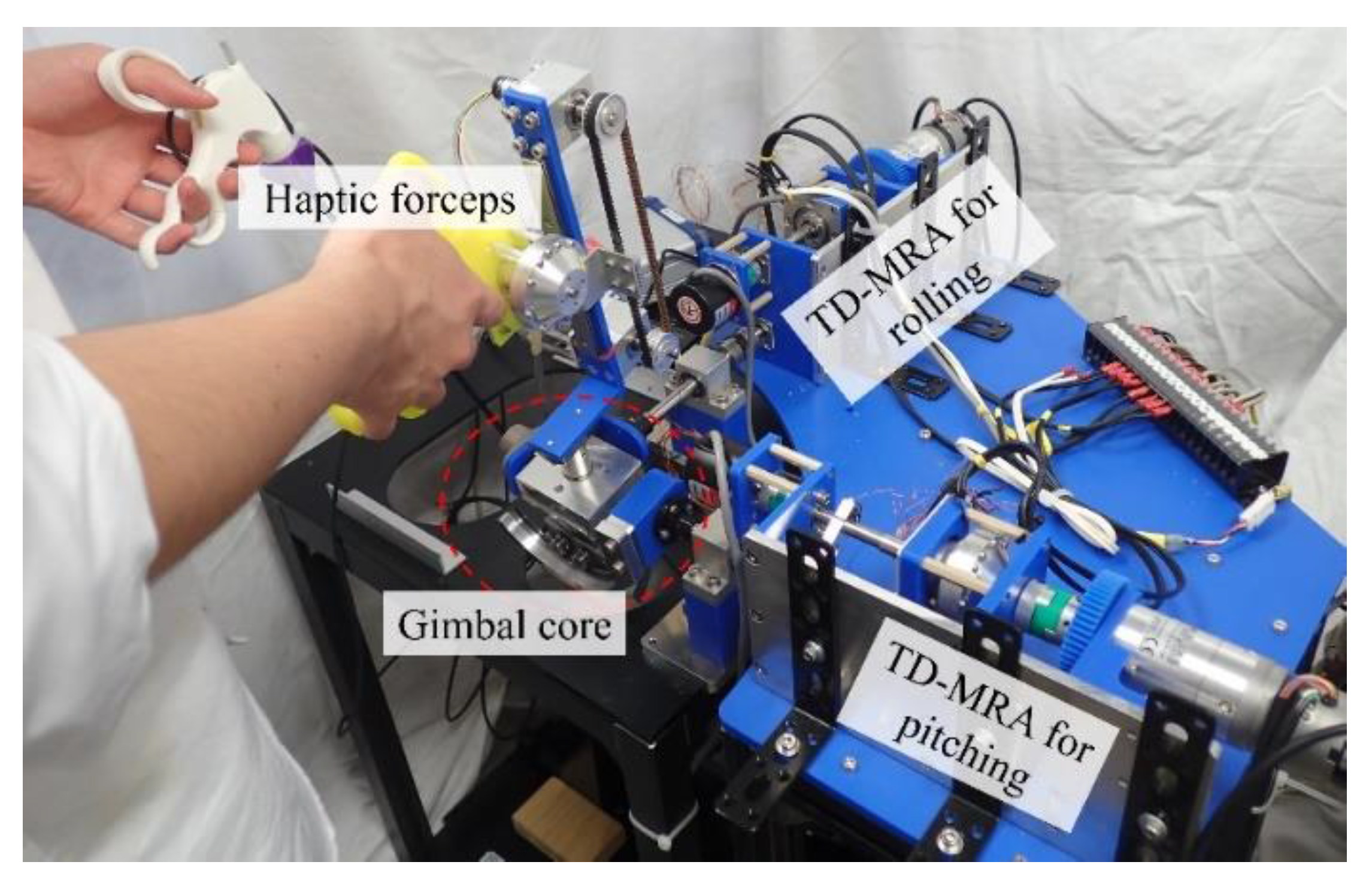




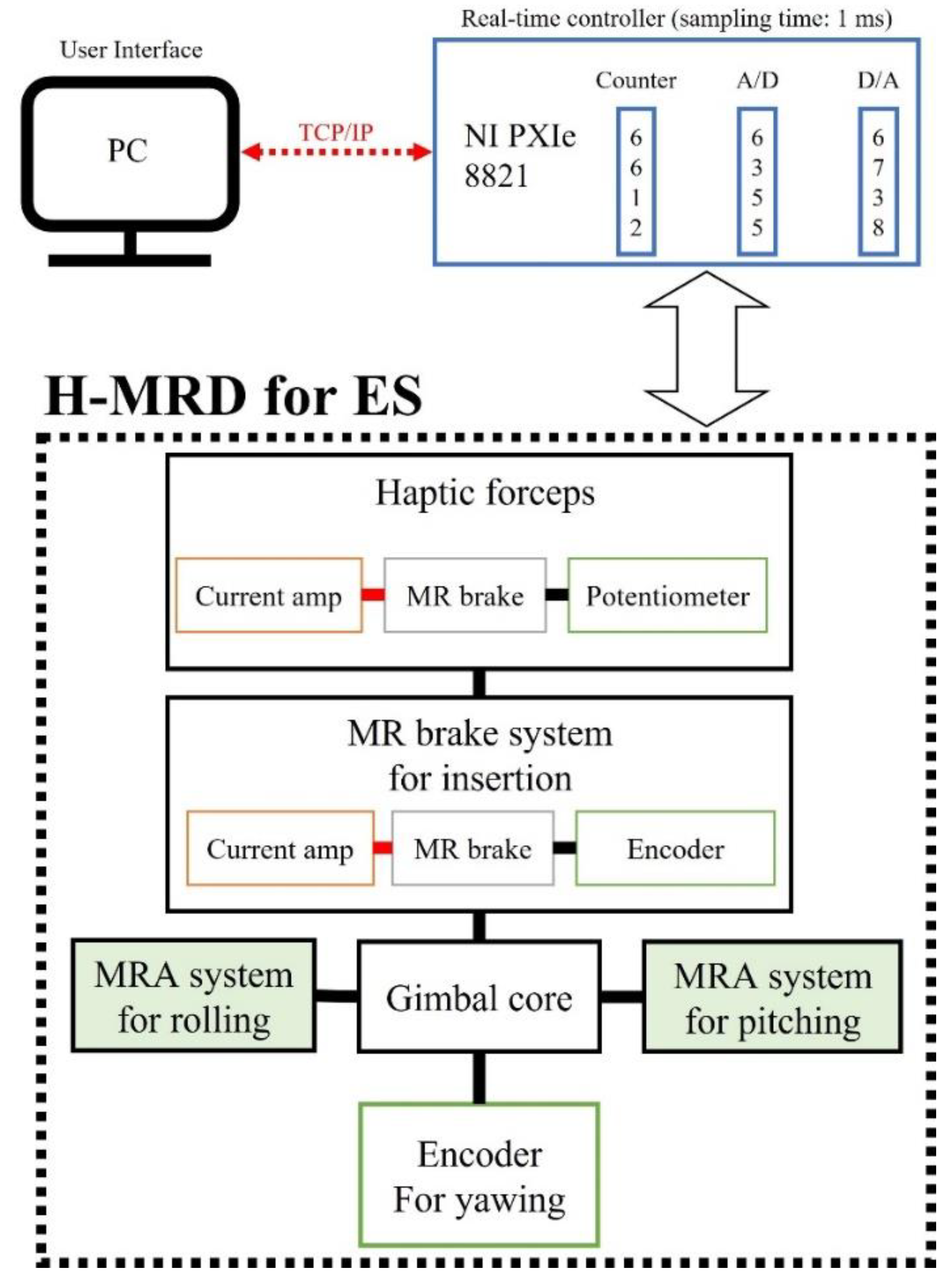

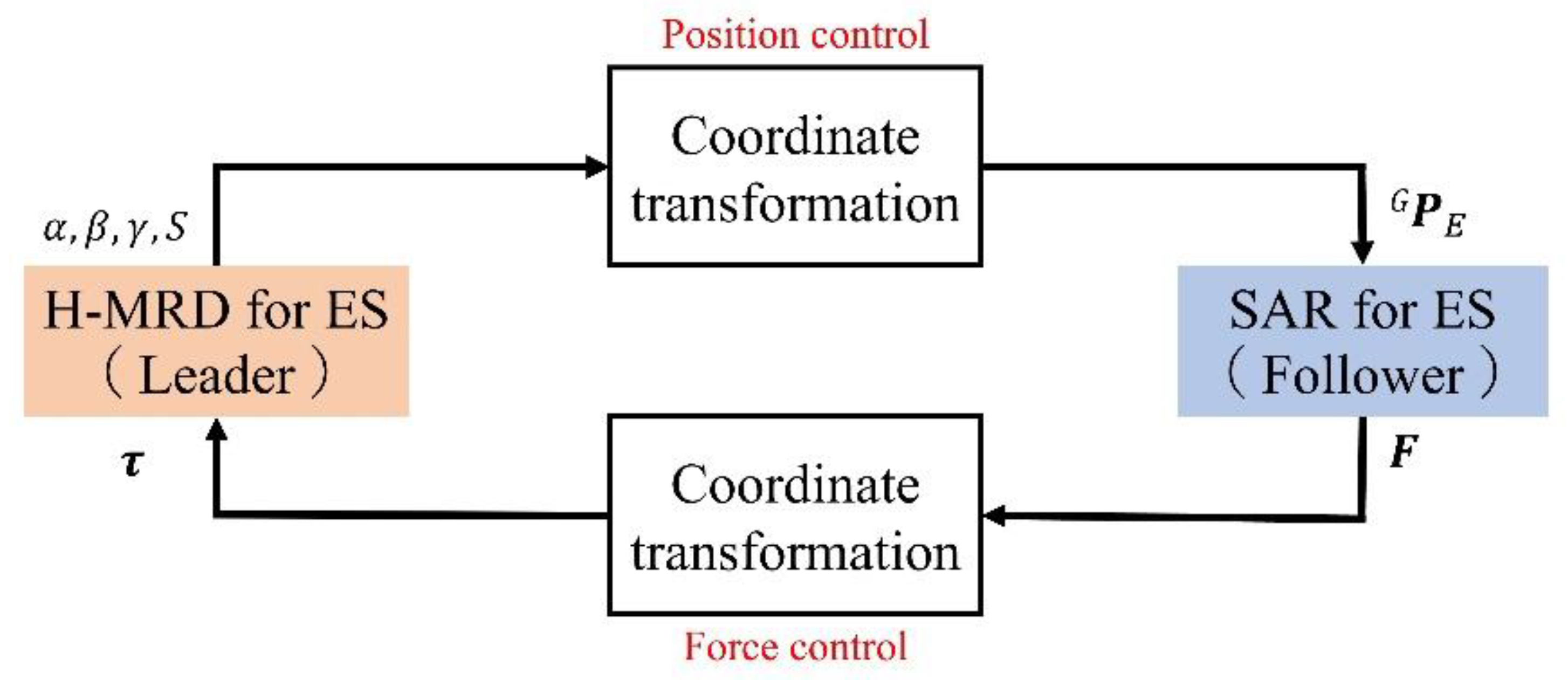
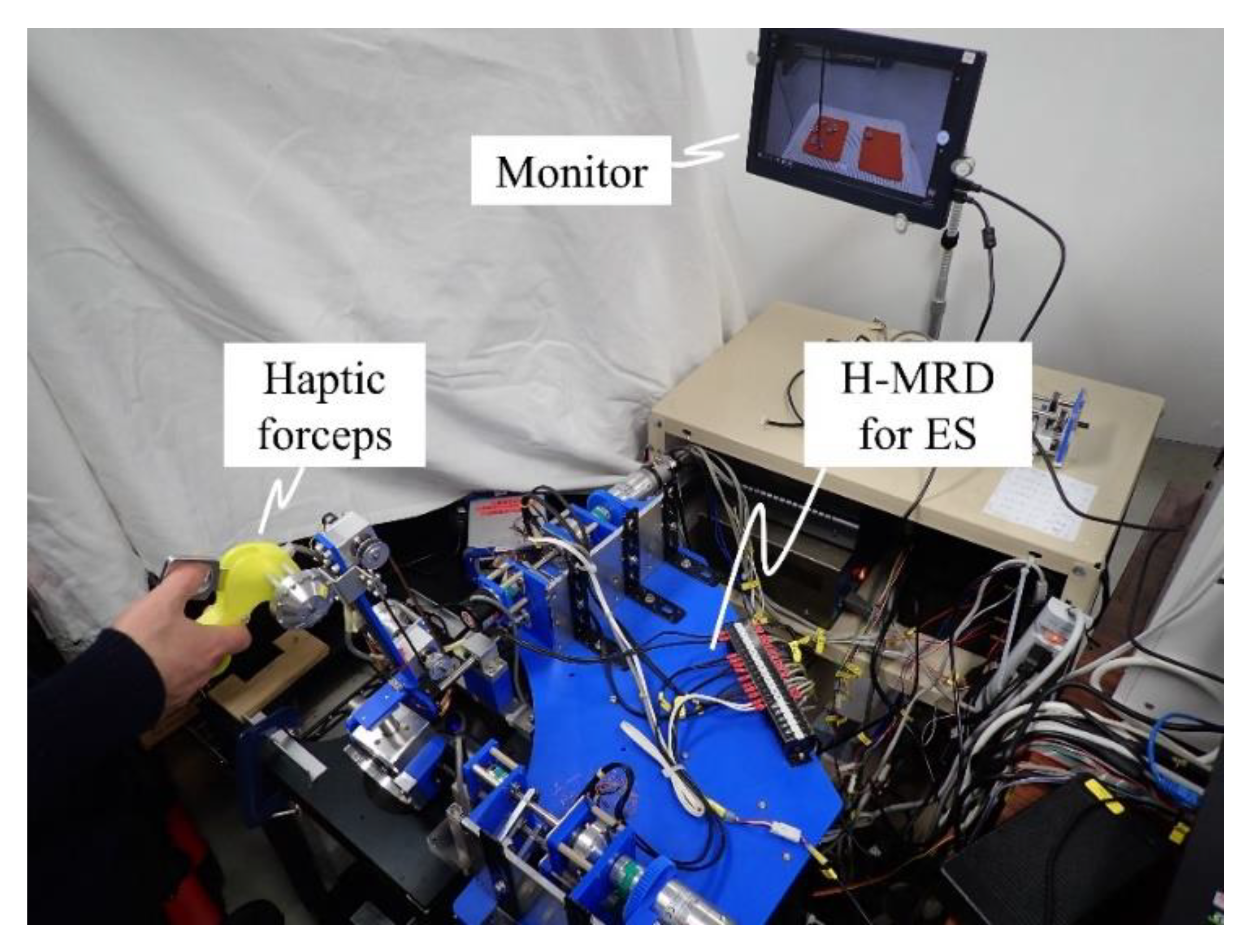
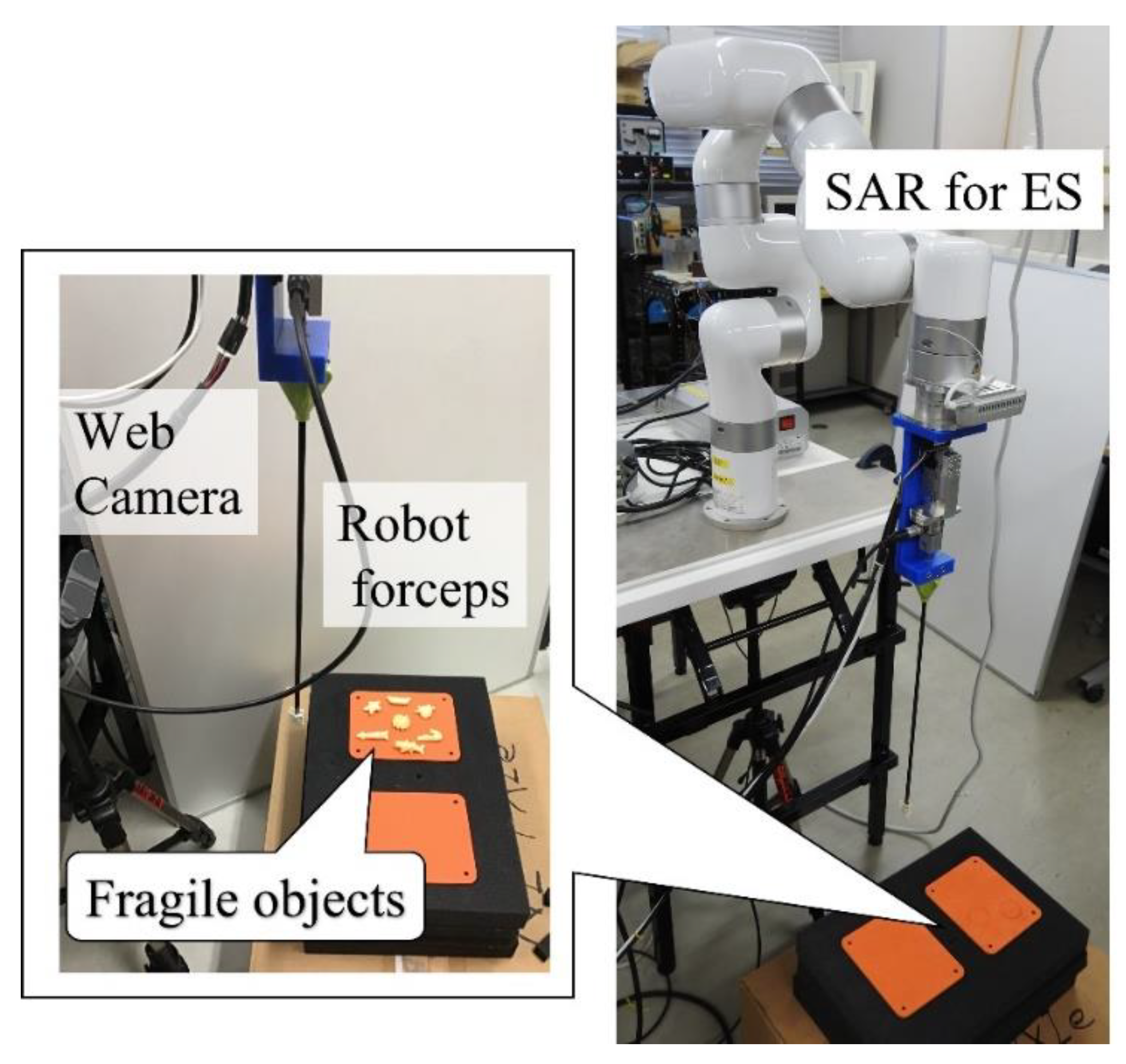
| Item | Value |
|---|---|
| ROM for roll | −30°–60° |
| ROM for pitch | −45°–45° |
| ROM for yaw | −45°–45° |
| Maximum reaction force on the handgrip | 3 N (min) |
| ROM of gripper | −15°–15° |
| Maximum reaction torque for griping | 0.64 Nm |
| Subject | (H1) Haptics 1 | (N) No Haptics | (H2) Haptics 2 |
|---|---|---|---|
| A | 1/1 | 3/4 | 3/5 |
| B | 2/4 | 2/6 | 3/6 |
| C | 1/3 | 0/3 | 1/3 |
| D | 1/2 | 1/3 | 4/4 |
| E | 1/3 | 0/2 | 2/4 |
| Item | (H1) Haptics 1 | (N) No Haptics | (H2) Haptics 2 |
|---|---|---|---|
| (a) Mental demand | 0.491 ± 0.272 | 0.710 ± 0.260 | 0.532 ± 0.348 |
| (b) Physical demand | 0.464 ± 0.287 | 0.643 ± 0.172 | 0.548 ± 0.251 |
| (c) Temporal demand | 0.594 ± 0.324 | 0.709 ± 0.258 | 0.499 ± 0.248 |
| (d) Performance | 0.492 ± 0.319 | 0.708 ± 0.179 | 0.412 ± 0.248 |
| (e) Effort | 0.580 ± 0.220 | 0.749 ± 0.242 | 0.412 ± 0.140 |
| (f) Frustration | 0.416 ± 0.348 | 0.560 ± 0.277 | 0.470 ± 0.300 |
| Item | (N-H1) | (H2-H1) |
|---|---|---|
| (a) Mental demand | 0.220 | 0.041 |
| (b) Physical demand | 0.179 | 0.084 |
| (c) Temporal demand | 0.115 | −0.095 |
| (d) Performance | 0.216 | −0.080 |
| (e) Effort | 0.172 | −0.109 |
| (f) Frustration | 0.145 | −0.047 |
Publisher’s Note: MDPI stays neutral with regard to jurisdictional claims in published maps and institutional affiliations. |
© 2021 by the authors. Licensee MDPI, Basel, Switzerland. This article is an open access article distributed under the terms and conditions of the Creative Commons Attribution (CC BY) license (https://creativecommons.org/licenses/by/4.0/).
Share and Cite
Kikuchi, T.; Takano, T.; Yamaguchi, A.; Ikeda, A.; Abe, I. Haptic Interface with Twin-Driven MR Fluid Actuator for Teleoperation Endoscopic Surgery System. Actuators 2021, 10, 245. https://doi.org/10.3390/act10100245
Kikuchi T, Takano T, Yamaguchi A, Ikeda A, Abe I. Haptic Interface with Twin-Driven MR Fluid Actuator for Teleoperation Endoscopic Surgery System. Actuators. 2021; 10(10):245. https://doi.org/10.3390/act10100245
Chicago/Turabian StyleKikuchi, Takehito, Tetsumasa Takano, Akinori Yamaguchi, Asaka Ikeda, and Isao Abe. 2021. "Haptic Interface with Twin-Driven MR Fluid Actuator for Teleoperation Endoscopic Surgery System" Actuators 10, no. 10: 245. https://doi.org/10.3390/act10100245





